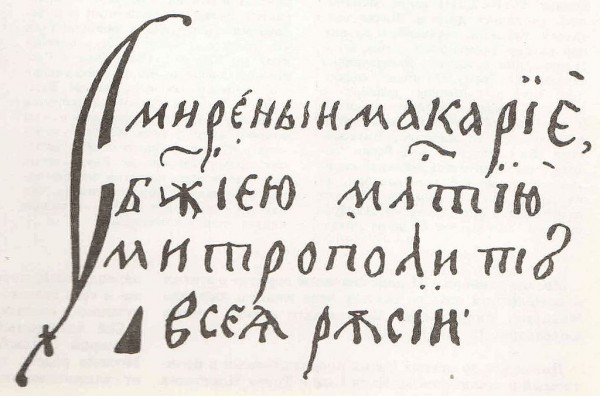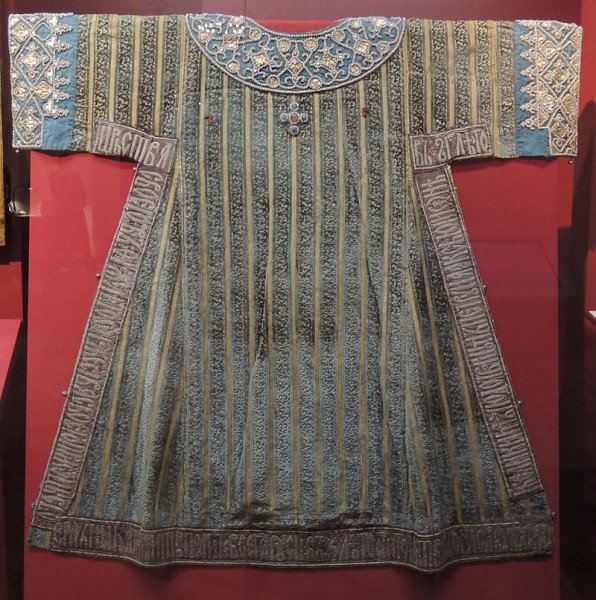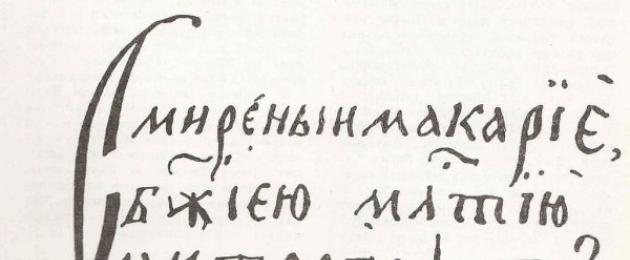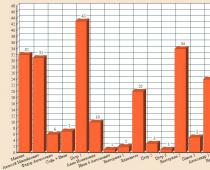(The saint who glorified the Lithuanian martyrs and established the Polotsk see of the bishop)
Metropolitan Macarius was called Michael in the world.
Macarius - Metropolitan of Moscow and All Russia (since 1542), in 1526-1542 - Archbishop of Novgorod. A supporter of Josephism, a follower and relative of the Monk Joseph Volotsky.
Born around 1482 in Moscow into a family of pious parents. At baptism, he was named in the name of the Archangel Michael. It is known that his father's name was Leonty. Mikhail's father apparently died shortly after the birth of his son. His mother later took monastic vows with the name Euphrosyne.
Deciding to choose the monastic path for himself, he entered the Nativity of the Virgin Pafnutiev-Borovsky Monastery as a novice. During his tonsure, he was named after the famous Orthodox hermit ascetic, St. Macarius of Egypt. The future saint entered the monastery of St. Paphnutius when Joseph Volotsky left him. Nevertheless, the influence of the Volotsk hegumen on the future metropolitan is very great.
In 1523 he became hegumen of the Luzhetsky Bogoroditsky Monastery in Mozhaisk. In 1526 Macarius was ordained Archbishop of Novgorod and Pskov. The Novgorod department by this time had been widowed for 17 years. The long-term absence of the diocesan bishop did not have the best effect on the state of her affairs. The necessary measures were aimed at implementing the decisions of the councils of 1503-1504. Cohabitation in the monastery of monks and nuns was forbidden. In women's monasteries, abbots were replaced by abbesses. White priests were ordered to serve in women's monasteries. Secular persons who lived at the monasteries were removed from there. Being a consistent supporter of a strong monastic economy, the new archbishop made considerable efforts to transfer the Novgorod monasteries to a cenobitic charter. As early as 1528, out of 24 monasteries in the diocese, only four were cenobitic, the rest were special. Saint Macarius, by persuading the abbots of the monasteries, achieved that by the end of his service in the Novgorod diocese the number of kinovias had reached eighteen.
It was noted that during the reign of Saint Macarius in Novgorod there was bread cheaper than before, reduced taxes from monasteries, organized free meals for all orphans, and the saint was called nothing more than "Protector of the people."
Macarius contributed to the compilation of the new Vladychny Chronicle. Vladyka paid much attention to the restoration of ancient icons and temples, and frescoes were renewed in St. Sophia Cathedral. Here, in Novgorod, the first attempt was made to collect together all the books “what are in the Russian land”, the first edition of the famous “Makaryevsky Menaia”. The collection included both the lives of the saints, as well as didactic and theological works. In 1541, all 12 volumes of the collection were transferred to the library of St. Sophia Cathedral.
Saint Macarius was a great prayer book, he even read and performed the rules of the entire daily code on the road. Miracles were performed through his prayers, in Moscow they believed that it was he who begged God for a boy who went down in history as Tsar Ivan the Terrible, through his prayers a relative of St.
He was elevated to the metropolitan throne on March 19, 1542 by the boyar group of princes Shuisky, who ruled under the juvenile Ivan the Terrible.
Saint Macarius himself recalled: “I don’t know by what fate of God I was chosen, humble, not only by the whole cathedral of the Russian Metropolis, but also by the most pious and Christ-loving tsar and Grand Duke Ivan Vasilyevich, autocrat of all Russia.”
In this rank, Macarius replaced Metropolitan Joasaph, deposed by the Shuiskys. However, he soon, like his predecessor Joasaph, began to oppose the Shuiskys. Possessing considerable influence on the young tsar, he contributed to the removal of the Shuiskys from power, which took place in December 1543. After that, Macarius had a great influence on the policy of Ivan the Terrible, entering the so-called "Chosen Rada". He crowned Ivan the Terrible to the kingdom (1547), contributed to his marriage to Anastasia Zakharyina.
Not all boyars liked Saint Macarius, and Tsar Ivan the Terrible, in personal conversations with the metropolitan, often reminded him how the boyars tore the mantle of the metropolitan.
The saint actively contributed to the strengthening of autocratic power in Russia and for the first time in history crowned Ivan the Terrible with a royal crown. Until now, only the Patriarch of Constantinople and the Pope of Rome could perform such a royal wedding to the throne. Metropolitan Macarius wanted to see Moscow as the center of the Orthodox world. The hierarch himself, addressing Ivan the Terrible, said: “The Lord God Himself on this earth chose this place for you and raised it to His throne with His grace. according to his royal rank and rank"
All this was done without the consent of the Eastern Patriarchs. But soon a delegation from Constantinople arrived in Moscow to ask Moscow for financial assistance, in return they brought a particle of the relics of St. George the Victorious and the Recognition of the Royal Crown of St. Macarius over Ivan the Terrible. Ivan the Terrible promised to help Byzantium, but once again asked Constantinople to confirm that Byzantium officially honored him as the Tsar of Russia. Constantinople was not immediately ready to recognize Ivan the Terrible as Tsar crowned king by Macarius, and the Greeks themselves wanted to remarry Ivan the Terrible with a crown from the Patriarch of Constantinople. But everything was decided by the case of the conquest of the Kazan Kingdom.
Ivan the Terrible also provided financial assistance to the Sinai Monastery and in return asked the Patriarch of Alexandria to pray for him as for the Tsar of Russia.
But Lithuania and Poland did not recognize the royal crown from Metropolitan Macarius over Ivan the Terrible and continued to consider Ivan the Terrible a prince. Saint Macarius even appealed to the Catholic clergy of Lithuania and Poland, so that the Catholic bishops would promote recognition before their princes and Sovereigns.
Soon there was a drought and a strong fire in Moscow, the metropolitan residence burned down, and Vladyka had a severe burn in his right eye. When the Metropolitan was asked how this could happen to him, Metropolitan Macarius replied: "All this is due to my sins!"
In 1547 and 1549, he convened two Councils in Moscow, at which a great deal of work was done on the canonization of Russian saints, including Alexander Nevsky, Alexander Svirsky, Nikon of Radonezh, Savva Storozhevsky .... In connection with the glorification of the new saints, under the leadership of the metropolitan, a great deal of work was done to compile the lives.
It was Metropolitan Macarius of Moscow who glorified in 1549 in the face of the holy Vilna martyrs Anthony, John and Eustathius.
Under him, in 1551, the famous Stoglavy Local Council of the Russian Orthodox Church was held. Sympathizing with the Josephites who dominated the Stoglavy Cathedral, he did not allow the adoption of the law on the secularization of monastic lands, promoted by Archpriest Sylvester.
Macarius put a lot of effort into organizing the printing business in Russia. Under him, the first printing house was opened in Moscow for printing sacred and liturgical books.
Saint Macarius ordained 21 bishops. Under Saint Macarius, the Polotsk and Kazan sees of the bishop appeared.
Saint Macarius was not afraid to enter into dialogue with Lutheran bishops who arrived from Sweden and with Catholic bishops from Poland.
It was Saint Macarius who introduced the tradition on Palm Sunday of driving the head of the Russian Church to the temple on a donkey.
As for liturgical instructions in the Russian Church, Metropolitan Macarius issued all decrees only at his own discretion, Tsar Ivan the Terrible, under Metropolitan Mokaria, did not interfere in Church affairs and treated the saint with great respect.
St. Macarius consecrated the first Church of the Intercession, now on this site the Church of St. Basil the Blessed, but it was St. Basil the Blessed who attended the services of St. Macarius during his lifetime.
Saint Macarius baptized and buried members of the royal house of Ivan the Terrible. Buried the first Russian Empress Anastasia Romanova. He also baptized Princess Mary of Cherkasy, and then married her to the tsar.
The saint read Holy Scripture daily and knew it well. I personally struggled with conversations and laughter in the temple ..
After the fall of the Chosen Rada in 1560, Macarius, the only one of its members, was not persecuted.
On December 3, 1563, Metropolitan Macarius informed the sovereign that, due to weakness, he intended to leave the metropolis and “go back to a silent life” to the place of his tonsure in the Pafnutiev Monastery. The sovereign, together with the heir, appeared at the metropolitan courtyard and begged him not to leave the metropolis. Only on December 21 did he agree to remain in the chair, but 10 days later, on the last day of 1563, Vladyka Macarius died.
On January 1, 1564, he was buried in the Assumption Cathedral. The burial was headed by Archbishop Nikandr of Rostov, 4 bishops co-served with him.
Saint Macarius was for 16 years the second person of the Russian Church, and then for more than 20 years he headed it.

SOME INTERESTING FACTS ABOUT ST. MACARY OF MOSCOW
It is interesting that in the Russian Church white metropolitan hoods were worn only by Saints Peter and Alexy, all other saints, heads of the Russian Church. Metropolitans of Moscow wore black hoods. White hoods in the history of the Russian Church were worn only by the Novgorod lords and only the Novgorod lords sealed their letters and letters with a red seal, and the Moscow metropolitans, like all other bishops of Russia, with a black one.
It is known that Metropolitan Macarius was lord of the Novgorod cathedra for 16 years and had an advantage over all other Russian lords to wear a white hood and seal letters with a red seal.
And therefore, when he was promoted to metropolitan to the Moscow cathedra, he refused to lay down his white hood and continued to wear a white hood and seal letters with a red seal.
The popularity of the metropolitan was so high that no one dared to remove the white hood from the bishop. But Tsar Ivan the Terrible did not interfere in Church affairs. The white hood on the Moscow metropolitan was considered a personal matter of the lord himself, and the metropolitan himself believed that if he was promoted to rank, then he could not put on the clothes worn by the lords standing below the lord of Novgorod.
at the same time, it can be said that Saint Macarius used a white hood and a red seal "arbitrarily" against the canons of the Russian Church, and only after his earthly death, when the question arose of what color the hood should now be worn by the Metropolitan of Moscow, it was officially decided that it should be WHITE following the example of the first saints Peter and Alexy, they also approved the red seal for the Metropolitan of Moscow.
Historians say that in terms of literary activity, Saint Macarius was a man of outstanding erudition. But to speak about his thinking as a statesman, he had no knowledge of non-theological subjects, and there was no systematic education for that time, for the saint did not even have a school education.
And therefore, he could not, in any way, participate in the upbringing of the young Tsar Ivan the Terrible and be his teacher. The Metropolitan experienced this fact with sadness. He felt himself standing apart from the king. And so it was necessary to approach and do something. Here the thought ripened, "to push the idea" to the 16-year-old ruler of Russia, that it's enough to be a prince, you need to become a Tsar. Ivan the Terrible liked the idea and the very next day he himself announced that he wanted to be Tsar and that Metropolitan Macarius would crown him to the Tsardom. For the rest of their lives, the tsar and the saint were very grateful to each other. In one evening, more was done than if in 16 years of education of the young king.
Saint Macarius was the first primate of the Russian Church who agreed to negotiate with the Lutherans and Catholics on an equal footing, and by this he also elevated the Church, because neither before him nor after the saints refused any dialogue with the West. And here we see that St. Macarius, already in negotiations with foreign bishops, is acting as an international politician.
Before Metropolitan Macarius, there were 22 Russian saints in the Russian Church; Saint Macarius canonized 39 Russian saints during his reign.
Interesting data is that previously monastic priests had primacy in the Church, but Metropolitan Macarius was at first a married priest and it is known that he had a daughter who died by the time of his metropolitan ordination. Perhaps because the saint showed special concern for the white married clergy and was considered a very kind lord who defeated conservative despotism, especially in relation to monks married priests.
Saint Macarius is famous for the fact that during the period of his archpastoral activity, on his initiative or under his influence, such events took place in the church-historical life, which were not like anything in previous history.

Sakkos of Metropolitan Macarius. 1549. Moscow, workshops of the Kremlin. Fabrics - Italy, 1st half. 16th century. Golden velvet, damask, silver, pearls, precious stones, embroidery, basma. An inscription is embroidered on the vestment that this sakkos was presented to Metropolitan Macarius by Tsar Ivan IV "for the glory and praise of God and for the honor of many years of health to his kingdom and prosperity."
- In contact with 0
- Google+ 0
- OK 0
- Facebook 0








